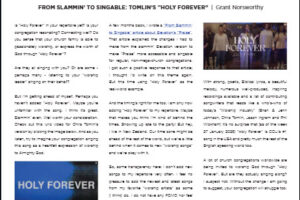Are we hoping to enthrall the viewing audience with a concert-like musical performance? Or are…

PERSONAL IN-EAR MONITORS STILL NEED THE AUDIO TECH
By Grant Norsworthy
You’ve arrived!
You’ve upgraded your old open speaker wedge monitor system for an in-ear system with personal digital mixing console for each band member. Or maybe you did that a LONG time ago. No more monitor problems, right?
Wrong.
The problems might not be so obvious anymore but they’ve just gone “underground”. The obvious, open warfare of speaker wedge volume has shifted to be guerrilla warfare, and the audio engineer still has an imperative role to play.
Sure. Now that each instrumentalist and singer on the platform is in control of their own monitor, it’s no longer your job to make them happy with their mix. That’s their job now! True.
But an audio engineer who considers their job is done once the signal reaches the monitor consoles is falling short of the service they should provide for the team on the platform. I would suggest that audio engineers need to step back into “monitor world” because of several problems that are being repeated over and over again.
PROBLEM 1: Channel confusion
I’ve heard it time and time again from an audio engineer: “Yeah, the channel labeled ‘electric guitar’ is nothing. Electric guitar is labeled ‘lectern’” – or something like that. (Insert the sound of musicians’ brain cells dying).
SOLUTION: Channel labeling must be correct and musical
Whether digital (on a screen) or “analog” (written on a piece of tape), the channel labeling must be as musician-proof as possible. (I did not say “idiot-proof” because that would suggest that musicians are idiots … but some of us are when it comes to tech.)
And while you’re at it, arrange the channel order in a way that makes musical sense: drums and bass next to each other, all vocals in a series, following as much as possible the position of the people on the platform and so on.
PROBLEM 2: Musicians are not technicians
Most likely your team of instrumentalists and singers are volunteer amateurs. Now we’re asking – no, insisting – that they also be mix engineers. They may already be sweating bullets, feeling underprepared, insecure and nervous with what they have to play and sing. Adding an extra layer of technical gobbledegook to their job description could tip them over the edge.
SOLUTION: You must teach (and re-teach) how to use the console
And by “teach” I don’t mean the 1 minute version. Any new person must also receive the training. And remember, teaching has not happened unless learning occurs. The only way to be sure that learning has occurred is if it is demonstrated.
As you teach, remember that this little “toy” console might be incredibly simple to you – the audio engineer. To many amateurs, volunteer church instrumentalists and singers, though, this box with its dials and lights and screen can be perplexing. It may even induce fear.
Keep your teaching simple but thorough. Don’t speak in audio tech language. Explain what monitors, level, pan, mute and mix are in simple terms. Don’t assume they know! And if they have questions or problems, they should feel free to ask for help.
PROBLEM 3: Confused, uninspiring, bad monitor mixes
Too many church bands confuse and overlap set-up, noodling, practice, rehearsal, and sound check. Sometimes doing 2, 3 or 4 of those at the same time. We don’t have time for that! And they never work properly when the lines between each are blurred. Players and singers end up with a personal monitor mix nightmare and no idea how to scoop themselves out of it.
Many will stay silent in their ordeal for fear of appearing incompetent. (We musicians tend to be an insecure bunch who worry too much about what others think of us.)
SOLUTION: Insist on a defined soundcheck with NOTHING else happening
Even with personalized monitors, take the time to systematically line-check the signal of each individual sound source to the consoles. Have each band member indicate that they have heard and set a starting point level for each. I prefer the rock fist in the air to show they have it done.
This needs to be an intentional, focused, defined time; with a clearly announced beginning and end. Everyone’s attention must be on the soundcheck and nowhere else. With good strong leadership from the audio tech in partnership with the band leader, this can be done quickly, efficiently and will uncover all manner of audio issues (“I don’t have that mic!” or “There’s a grounding buzz in the acoustic” or “That signal has digital distortion”, etc.) that will probably go unnoticed otherwise.
PROBLEM 4: The “More Me” monitor mix
I want the manufacturers of personal monitor consoles to add a second ⅛ ” headphone jack. (Come on, Behringer!) During sound check or rehearsal, audio engineers and band leaders should be able to easily plug in and hear what their band member is hearing.
(I have emulated this with an ⅛ ” splitter to listen to band members’ mixes as they rehearse. I found that the problem I am describing here is very common.)
You might be staggered by what you hear. For one thing, the levels can easily and unconsciously creep into hearing-loss realms. A second opinion of the overall level of the mix might save someone from going deaf! (Make sure you listen on their headphones too before making any definitive statement about this.)
Secondly – humans being the way we are (and perhaps musicians particularly so) – the tendency is to mix with our own performance way too prominent. Too much of ourselves in comparison to everyone else! We want to make sure we’re sounding great with little consideration for the overall sound the group is making.
I have heard it too many times. I have even seen online training videos and presentations at “worship conferences” where the instructor has taught this:
“Just have what you need in the mix. Mute or turn down everything else”
They might add, “I pretty much just have the click, the lead vocal and the acoustic guitar. That’s it. That way I can really focus on my playing. Make sure I’m on!”
I strongly believe that this is a terrible position to take when creating a personal monitor mix.
Should a singer or instrumentalist’s focus be mainly on their own performance? Surely not! Aren’t we here to focus on far bigger things than our own musical prowess?
SOLUTION: Have clearly defined and agreed goals for a good monitor mix
I don’t want to get ‘over-spiritual’ here. Yes, we should be focused on praising God and on leading a congregation to worship in song. But I want to speak on just a musical level: Our in-ear mix should represent the small role we get to play in a much bigger tapestry of sound. I ought not to be focused mainly on my sound – myself!
Our personal mix should clearly show that we – our singing or playing – are one of the contributing elements to an overall sound that has been carefully, intentionally crafted with the different pieces fitting together well.
So make sure each team member knows what they should be aiming for with their personal mix. If they don’t know what they’re aiming for, they’re sure to miss!
They need to be able to monitor their own performance – sure. But more importantly, they must be able to monitor how well their contribution fits, grooves and compliments all the other elements of the group’s sound. Their mix should inspire greater sonic cohesion as well as confidence in their own performance.I like this little mantra for monitor mixing taught to me by a wise head many years ago:
You should not hear JUST yourself. You should JUST hear yourself.
We don’t want a situation where instrumentalists and singers on the platform are unaware of the playing and singing of others in the ensemble. Inevitably, those performances will have inconsistencies, lack of togetherness, overlap in ugly ways and may even create dissonance and distraction.
So, audio tech! Please work your way back into the “monitor world” conversation. We musicians need you more than we realize or care to admit.
This article was first published by Worship Tech Director of the WFX Network on April 28, 2017.


